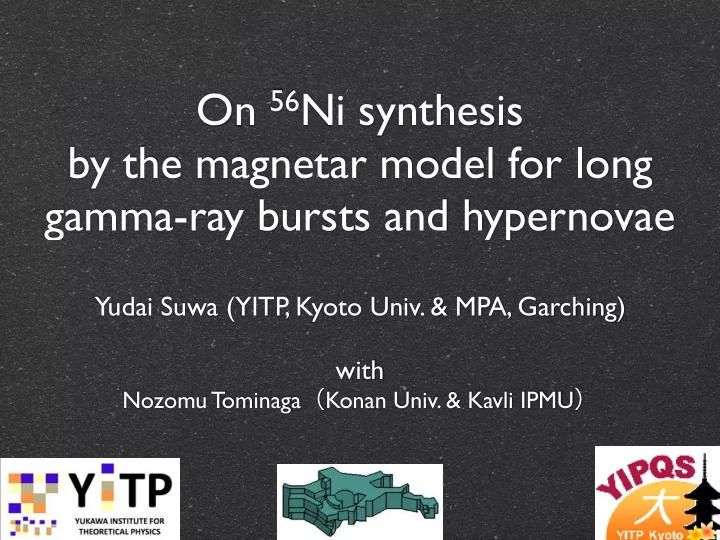

On 56 Ni synthesis by the magnetar model for long gamma-ray bursts and hypernovae Yudai Suwa (YITP , Kyoto Univ. & MPA, Garching) ! with Nozomu Tominaga ( Konan Univ. & Kavli IPMU )
Late activity of GRBs magnetar? Dall’Osso+ 11
GRBs and HNe GRB ! SN association Observations of GRB suggest GRB 980425 / SN 1998bw (z=0.0085) GRB 030329 / SN 2003dh (0.1687) that some GRBs are connected GRB 031203 / SN 2003lw (0.1055) with some kind of SNe. XRF 060218 / SN 2006aj (0.0335) GRB 100316D/ SN 2010bh (0.0591) ! GRB 130427A / SN 2013cq (0.3399) ... SNe which associate with GRB are “Hypernovae” (HNe) with explosion energy, E exp ~10 52 ergs. (~10 51 erg for canonical SNe) ! The central engine of GRBs is required to supply such an enormous explosion energy of Nomoto et al. (2006) GRBs/HNe.
56 Ni Nomoto et al. (2006)
Central engine models Collapsar scenario ; - consists of black hole (BH) and massive accretion disk as a end product of massive stars’ death - relativistic jets are generated in the vicinity of BH ( ν - driven? magnetic fj elds driven?) Magnetar scenario ; - rapidly rotating neutron star with super strong magnetic fj elds - jets are driven by magnetic pressure or magneto- centrifugal force
Can magneters generate 56 Ni? to construct a self-consistent model for GRB/HN, 56 Ni should be considered seriously
Picture expanding shell magnetar-driven wind magnetar hot bubble
Equations solved shock evolution Magnetar evolution w/ thin shell approximation � 2 � � 6 � � 4 � B p R Ω 6 . 18 × 10 51 erg s − 1 L w = . 10 16 G 10 4 rad s − 1 10 km d � � M s ˙ = 4 π R 2 R s s p − F g dt � − 1 / 2 � 4 π � � 4 π � � 1 + t d p = L w − p d 3 R 3 3 R 3 Ω ( t ) = Ω i s s dt γ − 1 dt T d � − 2 � � − 6 � � − 2 � � � B p R I Ω i T d = 8 . 08 s 10 16 G 10 4 rad s − 1 10 45 g cm 2 10 km (3 γ − 4) GM s (2 M c + M s ) ˙ s ˙ R s + 24 πγρ 0 R 4 R 3 s s ˙ 0 ˙ s + 3 ρ 0 ¨ +8 π R 5 R 2 R s ( ρ ′ R s ) � 2 � � � E NS = 1 I Ω i i = 5 × 10 52 erg � � 3( γ − 1) L w − (3 γ − 2) M s ˙ R s ¨ 2 I Ω 2 − 2 R 2 R s 10 45 g cm 2 10 4 rad s − 1 s ... � � 4 π G ( M c + M s ) ρ 0 ˙ +2 R 3 R s + M s = 0 , R s � s Suwa & Tominaga, MNRAS, 451, 4801 (2015)
Veri fj cation of model Suwa & Tominaga, MNRAS, 451, 4801 (2015)
Shock evolution L w =10 52 erg s -1 40 M ⊙ progenitor model by Woosley+ (2002) Suwa & Tominaga, MNRAS, 451, 4801 (2015)
Temperature evolution 56 Ni Necessary for Ni synthesis Suwa & Tominaga, MNRAS, 451, 4801 (2015)
M 56Ni Suwa & Tominaga, MNRAS, 451, 4801 (2015)
Magnetars for 56 Ni necessary condition for M 56Ni >0.2M ⊙ ! � 1 / 2 � � � Ω i B p � 0 . 68 10 4 rad s − 1 P=0.628 ms 10 16 G ! extremely strong magnetic fj elds and (almost) breakup rotation are required to explain HNe doesn’t match model parameters fj tting GRB afterglows and SLSNe (B~10 14 G & Ω ~O(10 3 ) rad s -1 ) we might need other mechanism (not dipole rad.) or other engine (BH wind?) to synthesize enough 56 Ni
Summary Q Can magnetar’s dipole radiation produce enough amount of 56 Ni explaining hypernovae? A Seems di ffj cult. We may need other mechanism to consistently explain hypernovae and GRBs with magnetar scenario
Recommend
More recommend